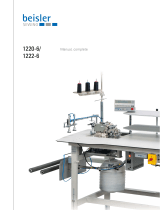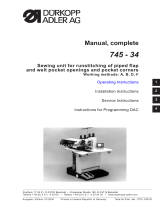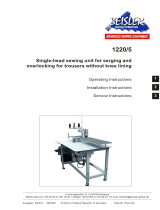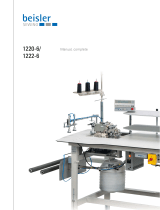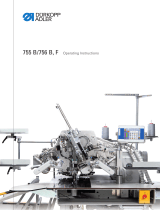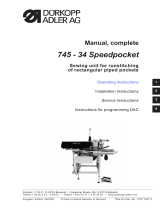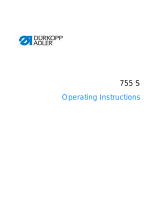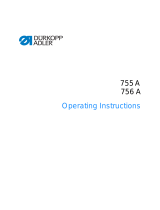Page is loading ...

Manual, complete
745-34
Sewing unit for runstitching of piped flap
and welt pocket openings and pocket corners
Working methods: A, B, D, F
Operating Instructions
Installation Instructions
Service Instructions
Instructions for Programming DAC
Postfach 17 03 51, D-33703 Bielefeld • Potsdamer Straße 190, D-33719 Bielefeld
Telefon + 49 (0) 5 21 / 9 25-00 • Telefax + 49 (0) 5 21 / 9 25 24 35 • www.duerkopp-adler.com
1
2
3
4
Ausgabe / Edition: 01/2004 Printed in Federal Republic of Germany Teile-Nr./Part.-No.: 0791 745161

745 - 34
Manual, complete
Summary
Operating Instructions
Installation Instructions
Service Instructions
Instructions for Programming DAC
Interconnection-diagram
9870 745100 B
9870 745115 B
9870 745116 B
9870 001018 B
Pneumatic circuit plan
9770 745003

Contents page:
Part 4: Instructions for Programming DAC, class 745-34
Program version A 03
1. General................................................... 3
2. Operating terminal ........................................... 4
3. Memory card
3.1 Saving and loading program data ................................... 5
3.1.1 Transferring program data from the memory card to the controller ................ 6
3.1.2 Transferring program data from the controller to the memory card ................ 7
3.2 Saving and loading the language version............................... 8
3.2.1 Transferring the language version from the memory card to the controller ........... 8
3.3 Transferring the machine software to the controller......................... 9
3.4 Changing the memory-card battery .................................. 9
4. Main operating screen
4.1 Sewing and test programs: menu structure .............................. 10
4.2 Changing parameter values ....................................... 11
5. Sewing programs
5.1 Calling sewing-program parameter screens ............................. 12
5.2 Running a machine program ...................................... 13
5.3 Main screen ................................................ 14
5.4 Pocket programs ............................................. 16
5.5 Blower mode................................................ 36
5.6 Pocket sequence ............................................. 38
6. Setting and test programs
6.1 Calling setting and test programs ................................... 40
6.2 Machine parameters ........................................... 42
6.3 Machine-specific setting and test programs ............................. 48
6.3.1 Adjusting the looper-thread monitor .................................. 49
6.3.2 Initialising memory ............................................ 50
6.3.3 Checking the smoother function .................................... 51
6.3.4 Aligning the light barriers ........................................ 52
6.3.4.1 Preparing the sewing unit and feed clamps .............................. 53
6.3.4.2 Sewing unit with two light barriers for automatic angle recognition ............... 55
6.3.4.3 Sewing unit with two light barriers, left or right flap positioning ................. 57
6.3.4.4 Sewing unit with one light barrier.................................... 59
6.3.4.5 Error Display................................................ 60
6.3.5 Checking the corner-blade settings .................................. 61
6.3.5.1 Checking the corner-blade station ................................... 62
6.3.5.2 Checking the front left corner blade .................................. 62
6.3.5.3 Checking the rear left corner blade .................................. 62
6.3.5.4 Checking corner-blade movement ................................... 63

Contents page:
6.3.5.5 Corner-blade machine parameters................................... 64
6.3.6 Testing needle and centre-blade activation.............................. 66
6.3.7 Checking the tape feed ......................................... 67
6.3.8 Checking the gripper folder without feed clamp (versions B and F only) ............ 68
6.3.9 Checking the insertion process with feed clamp........................... 69
6.3.10 Step-by-step mode ............................................ 70
6.3.11 Determining the cycle time ....................................... 71
6.3.12 Checking and adjusting the piping knives............................... 72
6.3.12.1 Checking the piping knife motion.................................... 72
6.3.12.2 Setting the piping knife reference position .............................. 73
6.4 Multitest system .............................................. 74
6.4.1 Displaying the program version and check sum ........................... 75
6.4.2 Testing the RAM .............................................. 76
6.4.3 Selecting input elements......................................... 77
6.4.4 Checking input elements ........................................ 79
6.4.5 Selecting output elements ........................................ 80
6.4.6 CAN test .................................................. 83
6.4.7 Checking the sewing drive ....................................... 84
6.4.8 Error list .................................................. 85
6.5 Terminal self-test ............................................. 86
6.6 Display contrast value .......................................... 87
6.7 Editing the menu ............................................. 88
6.8 Adjusting the serial interface ...................................... 89
7. Error messages
7.1 Machine-program error messages ................................... 90
7.2 Sewing-motor controller error messages ............................... 90
7.3 Step-motor error messages ....................................... 91
7.4 CAN-Module error messages ...................................... 91
7.5 System error messages ......................................... 92

1. General
This manual contains important information on the safe and correct use
of the “DAC” (Dürkopp Adler Control) new-generation controller.
Screen images in this brief description
The symbol display on the various screens depends on the sewing
machine’s equipment and settings. The screen images illustrated in
this brief description may therefore not always correspond exactly with
the screens appearing in the controller display.
Operating terminal with graphic user guide
The operating terminal is fitted with an LCD display and a keyboard.
The user guide employs only internationally intelligible symbols,
supplemented with textual information in the selected language. The
various symbols are arranged in groups in the menu structure of the
sewing and test programs.
Simplicity of operation ensures rapid familiarisation.
Ease of programming
99 freely programmable pocket programs are available to the user,
which can be combined with any number of seam patterns.
20 pocket sequences.
Each pocket sequence can be composed of a maximum of 8
pocket programs in any order.
On the “slanting-pocket version” of the class 745-34 all practical
angles can be programmed by the operator,
who can thus dispense with the need to spend time and effort
readjusting the corner blades and programming seam displacements.
Setting and test programs
The MULTITEST comprehensive testing and monitoring system is
integral to the DAC controller.
A microcomputer carries out the control functions, monitors the sewing
process and displays incorrect operations and faults.
Errors and test results are shown in the LCD display.
If the machine is operating normally the display shows information
relating to operation and sewing.
In the event of an operating error or fault the function sequence is
interrupted. The display indicates the cause by means of the
appropriate error symbol.
In most cases the error symbol disappears once the error has been
rectified.
In some cases the main switch must be switched off for safety reasons
when the error is rectified.
Special programs facilitate mechanical settings and enable receiver
and transmitter elements to be rapidly tested without additional
measuring devices.
RAM memory card
The RAM memory card is a long-term storage medium for all
programmed data and for the transfer of the software version and the
operating language.
It enables data to be transferred to other sewing machines.
The controller transfers the data onto the memory card.
Stored data can be loaded from the memory card into a DAC controller.
This procedure can be repeated an unlimited number of times within
the memory card’s lifetime (approximately 4 years).
3

2. Operating terminal
Data input and output is done via an operating terminal with a colour
LCD display and a multipurpose keyboard.
RST (reset)
key
Colour display
Decimal
keypad
Cursor keys
OK key
ESC key Function keys
Key/key group Function
Function keys Call sewing-program parameter screens
(from the main screen).
Call test programs (after pressing the RST key)
Switch functions on and off.
Leave test programs and parameter screens.
Cursor keys change parameter values.
change parameter values.
ï, ð : select the symbol of the required parameter
ñ, ò : switch the parameter function on and off,
select the previous/next parameter-value stage,
activate the test program
Decimal keypad enter parameter values.
: change the parameter-value sign
Escape key display the old parameter value again.
OK key open window to set the selected parameter.
accept the set parameter value.
RST key leave machine program.
Halt current program.
4

3. Memory card
3.1 Saving and loading program data
The memory card (RAM card) is a long-term storage medium for
storing sewing programs and transferring sewing-machine software. It
enables sewing programs, seam patterns and machine parameters to
be transferred to other sewing units.
Write protection
Labelling panel
5

3.1.1 Transferring program data from the memory card to the controller
Machine parameters, program sequences and pocket programs can be
transferred to the memory card individually.
CAUTION:
The machine must not be switched off during the transfer of data to the
controller.
When programs are transferred from one machine to another only the
program sequences and pocket programs are transferred.
–
While the main screen is displayed insert the memory card in the
side of the controller in the direction of the arrow.
The panel with lettering must be towards the operator.
–
Select the transfer direction with the “F4” key.
–
Select the required parameter with cursor keys “ï”or“ð”.
A black background appears behind the symbol of the selected
parameter.
CAUTION: danger of breakage
The working mode is important.
Only transfer data for the correct working mode.
Machine parameters
Program sequences
Pocket programs
–
Press function key F5 .
The data transfer begins.
6

3.1.2 Transferring program data from the controller to the memory card
When saving to the RAM card all parameters are transferred.
–
While the main screen is displayed insert the memory card in the
side of the controller in the direction of the arrow.
The panel with lettering must be towards the operator.
–
The controller switches to save mode.
–
Select the transfer direction with the “F2” key.
–
Press function key F5 .
The data transfer begins.
Transfer arrows appear above the arrow in the centre of the
display.
They go out when data transfer is complete.
–
Remove the memory card.
The display switches back to the main screen.
7

3.2 Saving and loading the language version
3.2.1 Transferring the language version from the memory card to the controller
CAUTION:
The machine must not be switched off during the transfer of data to the
controller.
–
Turn on the main switch, press and hold down the “á” key
or
press the “RST” and “á” keys.
–
The “language-selection” screen appears.
–
Insert the memory card sideways into the controller in the direction
of the arrow.
–
Use the “ñ ”or“ò” cursor keys to select the required language
version.
–
Press the “F5” key.
The language transfer begins.
When transfer is complete OK appears on the screen.
–
Remove the memory card.
–
Turn the main switch on and off
or
press the “RST” key.
The unit starts with the new language version.
NB:
In the course of a program update the default language, English, can
be restored with the key.
8

3.3 Transferring the machine software to the controller
The machine software is transferred to the controller by means of a
“bootbox” or a notebook and loader cable.
The connection and operation of the bootbox are described in the
“Bootbox for manual and automatic sewing machines
with DAC2A/B controllers”
operating instructions, part no. 0791 100621.
The connection and operation of the notebook and loader cable are
described in the
“Loader cable for DAC2A/B controller”
operating instructions, part no. 0791 100622.
3.4 Changing the memory-card battery
Memory-card retention period with no change of battery: approx. 4
years.
CAUTION:
Programs stored on the memory card will be erased when the battery
is changed.
Load programs into a controller before changing the battery.
9

4. Main operating screen
4.1 Sewing and test programs: menu structure
The user interface exclusively employs internationally intelligible
symbols.
In addition each function is briefly explained in an information line.
The individual parameters and setting and test programs are arranged
in various groups.
Turn on
main switch
Main screen
Sewing programs Setting and test programs
Calling sewing programs
–
Turn on the main switch.
The controller is initialised.
The DÜRKOPP-ADLER logo briefly appears in the display.
–
The display switches to the main screen.
Sewing-program parameter menus are called by pressing one of
the function keys F1 and F2.
Calling setting and test programs
–
Turn on the main switch.
The controller is initialised.
The DÜRKOPP-ADLER logo briefly appears in the display.
–
While the logo is displayed press one of the function keys F1 to
F5 or cursor up, cursor down.
or with the machine switched on:
–
press the RST key, then hold down one of the function keys F1 to
F5 or cursor up, cursor down.
The display switches to the corresponding group of setting or test
programs.
10

4.2 Changing parameter values
Parameter values are changed in the individual parameter screens.
–
Select the required parameter with the “ï ”or“ð ” cursor keys.
A black background appears behind the symbol of the selected
parameter.
–
Press the OK key.
The settings window appears with the current values or to enable
values to be entered.
–
Change the parameters as described under 1 to 4 below.
–
Press the OK key.
The new parameter settings are saved.
When changing parameter values we must distinguish among four
groups of parameters:
1. Functions that are switched on and off
–
Switch the parameter function on and off with the “ð ”or“ï” cursor
keys.
(on) (off)
2. Parameters with various functions
–
Set the required parameter function with the “ð ”or“ï” cursor
keys.
3. Parameters whose values are changed in stages
–
Select the previous or next parameter-value stage with the “ñ ”or
“ò” cursor keys.
Entry:
10, 12, 14, 16, 18, 20, 22 24
4. Parameters whose values are entered with the decimal keypad
–
Enter the required parameter value on the decimal keypad.
CAUTION:
The value must be within the set limits.
If the value entered is too large or too small, the upper or lower
limit is displayed when the Enter key is pressed.
[-20 ...+20]
–
If a plus or minus sign appears in front of the parameter value, it
can be changed with the “ ” key.
11
20

5. Sewing programs
With Class 745-34 you can program up to 99 different sewing
programs.
The individual sewing programs (pocket programs) are freely
programmable.
20 independent pocket sequences are available. Each pocket
sequence can be composed of a maximum of 8 pocket programs in any
order.
5.1 Calling sewing-program parameter screens
You can switch from the main screen to the various sewing-program
parameter screens with function keys F1 and F2. Function key F5
resets the piece counter to “0". Press F4 for the tape feed (if present).
Piece counter
Pocket Program Sequence
PP Seq
Parameters and sewing-program parameter screens
Pocket Program (PP) : parameters for programming the
seam and the
associated additional functions.
Sequence (Seq) : programming pocket sequences
Piece counter : daily piece counter
12

5.2 Running a machine program
–
Turn on the main switch.
The controller is initialised.
–
The Dürkopp Adler Logo briefly appears in the display.
–
The controller checks the position of the transport carriage.
The following display appears:
Info line:
Reference run
–
Start the reference run by pushing the left pedal back.
–
The display switches to the main screen of the sewing unit.
You can switch from the main screen to the various parameter
screens with function keys F1 or F2.
–
Press the RST key to leave the machine program.
The controller is re-initialised.
13

5.3 Main screen
The main screen displays the seam pattern, sewing program, selected
pocket sequence and important parameters.
Parameters can be individually selected by the user.
Info line
Seam pattern
The left half of the display shows the seam pattern of the selected
pocket program.
Sequence
A box indicating the sequence appears in the top right-hand corner.
Selecting program number and pocket sequence
The selected pocket sequence is displayed in the top right-hand
corner.
If automatic pocket-program switching is on, arrows are displayed
between the individual pocket programs of the sequence.
–
Select a pocket sequence with cursor keys “ñ”or“ò”.
“ò” : select next pocket sequence
“ñ” : select previous pocket sequence.
Selecting a pocket program in the current pocket sequence
In the pocket sequence the selected pocket program is shown in
reverse video.
–
Select a pocket program with cursor keys “ð”or“ï”.
“ð” : select next pocket program
“ï” : select previous pocket program.
14

Parameters
The symbols in the centre of the right half of the display give rapid
access to important parameters.
Up to ten parameters can be selected by the operator for display on
the main screen (see also section 6.7).
Parameters can be changed directly on the decimal keypad.
The number of the key to be pressed is displayed to the right of the
parameter symbol.
Example:
0: carriage-return to stand-by position
1: slide-in velocity
2: flap sequence
3: holder
4: vacuum
5: breast welt
6: pocket-program name
7: save pocket program
8: smoother
9: smoother time
The functions and settings of individual parameters are described in
more detail in section 5.4: Pocket programs.
The selection of the parameter symbols is described in section 6.7.
Info line
Text explaining the selected function is displayed in the information
line.
Piece counter
The current piece count is displayed at bottom right
(e.g. ).
The piece counter shows the number of pieces completed since the
counter was last reset.
The piece counter can be reset to “0" by pressing function key F5.
15

5.4 Pocket programs ( )
This menu item contains the parameters for programming the various
pocket programs.
They are used to program the seam and its associated additional
functions.
Info line:
Select pocket program
–
While the main screen is displayed press function key F1.
The display switches to the pocket-program screen.
–
The pocket program currently selected is shown in the upper part
of the display (e.g. “PP : 01”).
The program name, if any, appears behind it (e.g. “<SAKKO>”).
–
Select the required parameter with cursor keys “ï”or“ð”.
A black box appears under the symbol of the selected parameter.
–
Change the selected parameter as described in section 4.2.
–
Press function key F1 to switch back to the main screen.
Pocket-program number
This parameter selects the pocket program that is to be changed.
On completion of the entry the new pocket program and its program
name appear in the top left-hand corner of the display.
Entry: 1 .. 99
16

Programming the seam pattern
The actual pocket form is programmed under this menu item. The
programmed pocket is shown with the corresponding information in the
left half of the display.
The corresponding parameter symbols appear in the right half.
–
Select the required parameter with cursor keys “ï”, “ð”, “ñ”or
“ò”.
The symbol of the parameter selected appears in reverse video.
–
Press the OK key.
The corresponding submenu is called.
Seam-start flap shape
This parameter is used to select the shape of the flap at the seam start.
Three variants are available:
Straight flap
Slanting flap (left)
Slanting flap (right)
–
Select the required flap shape with cursor keys “ï”or “ð”.
–
Press the “OK” key.
The flap-angle entry window appears.
Flap angle
Entry: 01 ... 13 [mm]
17

Seam-start pattern
This parameter selects the form of the seam pattern at the seam start.
Straight seam pattern
Slanting seam pattern (left)
Slanting seam pattern (right)
–
Select the required seam form with cursor keys “ï”or “ð”.
–
Press the “OK” key.
The seam-angle entry window appears:
Seam angle
Entry: 01 ... 13 [mm]
Seam-end flap shape
This parameter selects the form of the flap at the seam end. Three
variants are available:
Straight flap
Slanting flap (left)
Slanting flap (right)
–
Select the required flap shape with cursor keys “ï”or “ð”.
–
Press the “OK” key.
The flap-angle entry window appears:
Flap angle
Entry: 01 ... 13 [mm]
18
/



